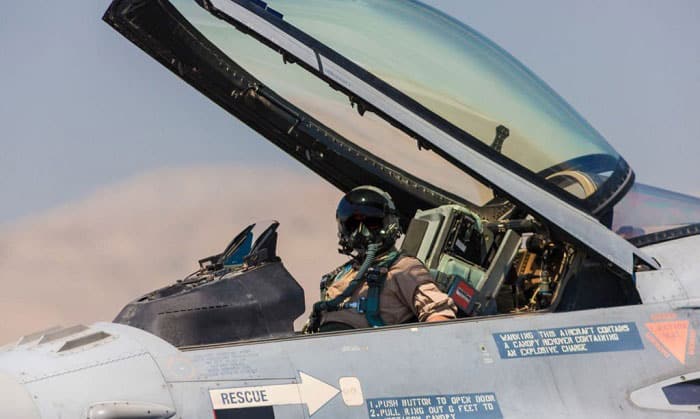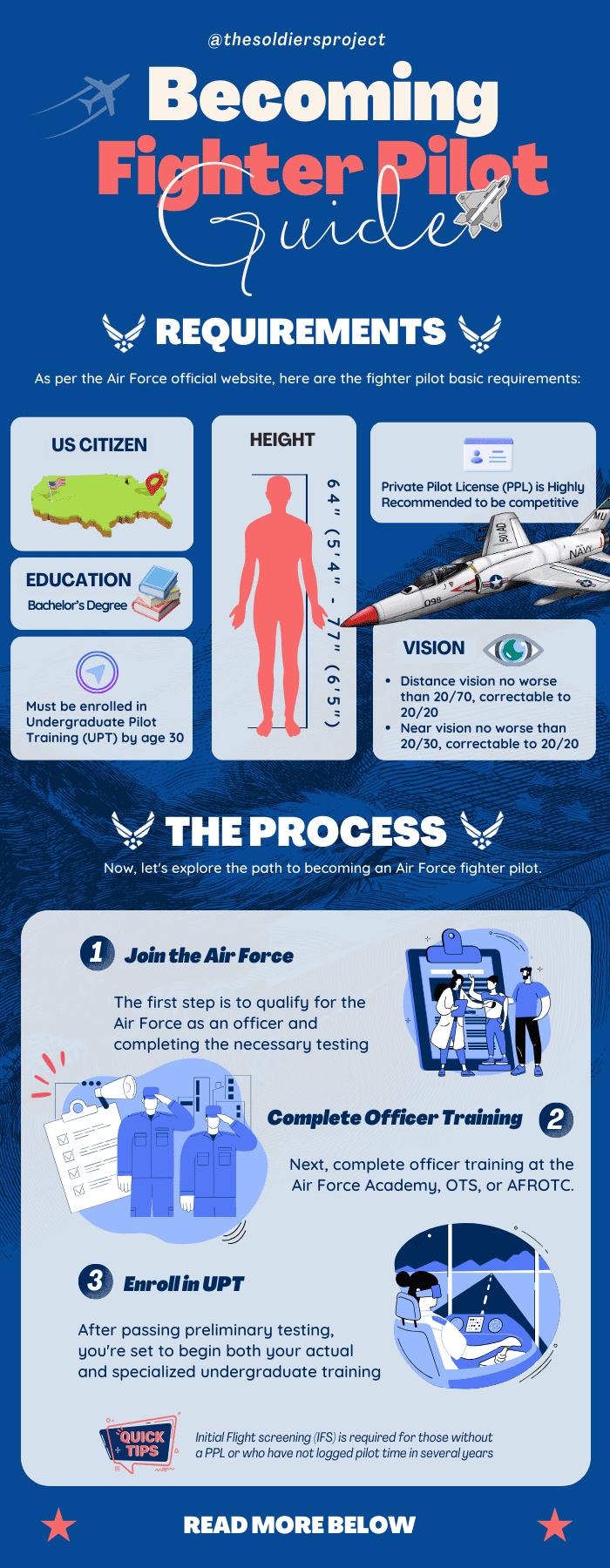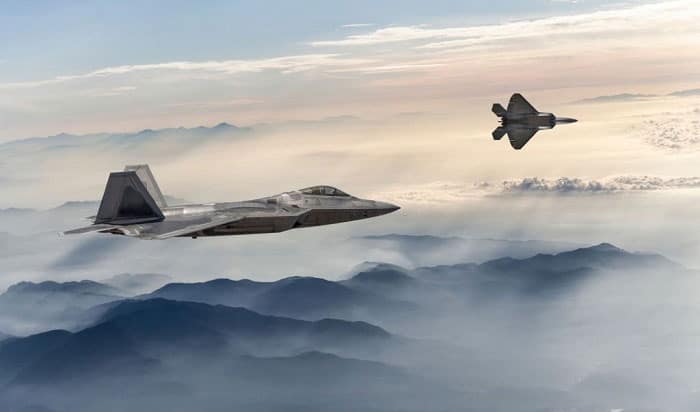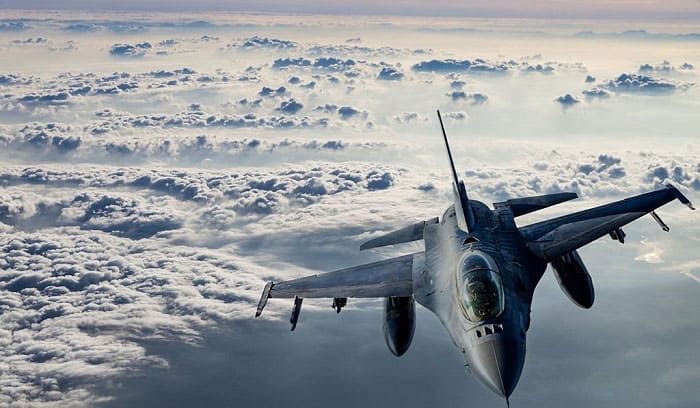Fighter pilots play an important role in the military. But there is currently a shortage of pilots! If you want to help fill this gap, become a military pilot! Our article will provide information on how to become a fighter pilot.
Table of Contents
Becoming a Fighter Pilot
What do military fighter pilots do?
First, let’s start with a basic description of what a military fighter pilot does. Wikipedia defines a fighter pilot as someone who is trained to engage in air-to-air and air-to-ground combat, and sometimes also electronic warfare from a fighter aircraft’s cockpit. They are typically part of the Air Force. So, this article will focus on the ways to become a fighter pilot in the Air Force.
How much do military fighter pilots earn?
According to Zip Recruiter, as of February 2022, the average monthly pay that fighter pilots earn is 5,427 dollars. This is equivalent to 65,126 dollars a year and 31 dollars an hour! In detail, the pay range is between 12,000 dollars and 144,000 dollars a year.
What are the requirements to become a military fighter pilot?
As listed on the Air Force official website, here are the basic requirements to be a fighter pilot.
The minimum education requirement is a Bachelor’s degree, and supplement qualifications are:
- Technical knowledge of mission tactics, flight theory, air navigation, meteorology, flying directives, and aircraft operation.
- Completion of:
- Air Force Specialized Undergraduate Pilot Training
- Single Scope Background Investigation
- Officer Training School / Air Force Academy / Air Force Reserve Officer Training Corps
Note: Pilot training must have started when you were between 18 and 33 years old.
The fighter pilot requirements also include physical characteristics, like standard height. This varies by aircraft, but applicants who are shorter or taller than average may have to go through a special screening procedure to make sure that they can securely carry out operational duties.
The three steps to become an Air Force fighter pilot.
Now that you have an idea of what is required to be a pilot fighter, let’s dive a bit deeper into the steps to becoming an airforce pilot.
1. Join the Air Force
The first step is to qualify for the Air Force as an officer. From there, you can “get your wings.” To enlist:
You need to be at least 17 years old and at most 37 years old. If you want to join as an officer, you must be older than 18 and younger than 39.
You must meet the height and weight standards, as follows:
You will need to be physically and mentally fit to perform optimally in the Air Force. There will be an evaluating process when you come to the MEPS: Military Entrance Processing Station. If you have a medical condition, your eligibility will be determined on a case-by-case basis. But be sure to provide the recruiter with all your medical documents for consideration.
Part of this is having ‘up-to-par’ vision. You may have eye refraction, but it should be no worse than plus-minus 8.0. You must also have no history of allergies, asthma, or hay fever after the age of 12.
Like enlisting in other branches, you must be a legal resident with a valid green card in the U.S. However, you need to be a native-born or a naturalized citizen to be an officer. Do not apply to join the Air Force while you are in the middle of obtaining U.S citizenship. Simply put, your enlistment application can only be accepted after you have finished the immigration procedures.
To enlist in the Air Force, you must also pass a series of tests: the ASVAB, the drug use test, and the background and criminal record check.
2. Complete Officer Training
Once you are in the Air Force, you need to go ahead and complete officer training. This can be done at the Air Force Academy, OTS, or AFROTC.
- Air Force Academy: This is a competitive school open for cadets across the country. You must be a U.S citizen between 17 and 23 years old, unmarried with no dependents, and of good moral character. Your prior academic record, GPA, and class rank will be evaluated, as well.
- OTS: This is short for Officer Training School. You will have to enroll in a program that lasts for 9 and a half weeks. it will be divided into 4 phases to challenge you physically and mentally.
- Phase 1 – Indoctrination: You will concentrate on standardization, discipline, and teamwork, and learn the basics of the Air Force culture, leadership, and military management.
- Examples of training that you will undergo include blue-line ceremony, processing, drill block, etc.
- Examples of academics include military custom and courtesies, profession of arms, personal and group goats, etc.
- Phase 2 – Development: You will sharpen your knowledge of the Air Force culture, leadership, and military management. You will also dive into the Air Force’s history, basic combat skills, and the significance of cross-cultural competence.
- Examples of training are hand-to-hand combat, M-9 qualifications, BELPS basic expeditionary leadership solving, etc.
- Examples of academics are airpower from pre-WWI, cultural shock, military law, leadership authority and responsibility, etc.
- Phase 3 – Application: You apply what you have learned by training the new lower class, leading your peers through officer training positions, and finally, passing an individual leadership evaluation.
- Examples of training are assault courses, small-unit tactics, LRC leadership reaction courses, and base defense field exercises.
- Examples of academics are leadership and management case studies, group dynamics, professional and unprofessional relationships, advocacy briefing measurement, and air and space system capabilities.
- Phase 4 – Transition: you will focus on mentoring and transitioning into an officer’s daily life and customs in the Air Force.
- Examples of training are AEF air expeditionary force exercise, first officer assignment, career day, etc.
- Examples of academics include the Army, Navy, Marine Corps panel, Oath of Officer, financial briefing, etc.
- AFROTC: This program is offered in over 1.100 higher education institutions across the country. It gives students the option to earn a degree while also preparing to become officers in the Air Force. Each university or college has different entry requirements. You can use this site’s tool to search for institutions offering AFROTC and learn the details.
3. Enroll in Undergraduate Pilot Training (UPT)
This is where you will begin your flight training.
Keep the following in mind as you prepare for your arrival at your UPT base.
- Plan to arrive a few days early, and do not arrive the day your class begins training. Upon arrival, report to the Transition Officer of the OSS (Operations Support Squadron). This is where the in processing takes place.
- Contact the Housing Office at your base to ask about the on-base housing opportunities. This is when you make your reservations.
- Contact the TMO (Traffic Management Office) to make arrangements for your deliveries of household goods.
- Contact the PSC (Postal Service Center) on your base to establish a mailbox or to forward your mail.
- Visit the Military Pay & Travel Pay sections of your MSS (Mission Support Squadron) and take care of any voucher issues.
- After your first day of training, go to Equipment Issue to receive your large assortment of new flight gear, including your flight suits, flight boots, jackets, bags, and assorted gear. The Transition Office will send you to the OSS Book Store, where you will be issued your manuals, textbooks, and flight publications, as well.
What You Should Bring to Your UPT Base
Use this as a checklist to make your in-processing as smooth as possible!
- 30 copies of orders (both front and back)
- Identification Card (i.e., military ID card and driver’s license)
- Proof of title, insurance, and car registration
- Money, credit card, or debit card
- Medical, dental, and shot profiles
- Traffic Management Office paperwork and receipts from the move
- Short sleeve blues and flight cap, flight suit if you have it, and flight or combat boots
- Mess dress for training graduation, service dress for an official photo, and ABUs for ground training
- All personnel records
- All receipts to sort out travel vouchers
Your UPT base will be smaller than the typical operational bases. Still, you will be able to find:
- a commissary for your grocery shopping
- an exchange for furniture, electronics, and clothes
- a gym and fitness center
- a convenience store
- a gas station
- a golf course
Generally, there will also be other recreational facilities.
If you are a married student, you have the option to live on base in a family housing or live off of the base. On the other hand, if you are a single student, you can live on base in the student dorms.
- Family housing often includes carports and yards.
- Student dorms have private kitchens and bathrooms.
The UPT has three distinct phases, which lasts for about 52 weeks:
- Phase 1 – Academics: Some things you will learn about: weather, aircraft systems, pilot physiology, and aerodynamics. Some lessons will be in traditional classroom lectures and some will be computer-based. For each subject, you must pass an exam – the passing rate is 85%. This ‘academics’ phase will last for about 4 to 6 weeks. Your schedule will be set by the OSS (Operations Support Squadron). Despite being named the ‘academics’ phase, you will also be expected to commit to physical training.
- Phase 2 – Flying the T-6: You will mostly be in your flight room with assigned instructors called IPs, learning the emergency processes, operating limitations, and boldface theory. Then, you will be introduced to the simulators, practicing how to run pre-flight checks and start the motor. Finally, you get to fly the T-6, and in doing so, learn basic maneuvers and traffic pattern operations, instrument flying, aerobatics, formation, etc.
- Phase 3 – Track Select: The 3 track options are flying the T-38C in the bomber, the T-1A in the tanker, or the UH-1 in the helicopter. You will continue with new sets of boldfaces and op limits. Here, you will fill out your dream sheet and order all the aircraft you want to fly in order. It is important to take this phase seriously because your ‘first assignment’ will be based on your performance in this phase.
Nearing the end, you will be assigned an aircraft (aka. get your seat assignment). This is decided based on your class ranking, training performance records, instructors’ recommendations, your dream sheet preferences and the AF needs.
Afterward, you continue flight training for the aircraft you were assigned for six months to one year. This is called Advanced Flight Training. Ultimately, you will be designated a squadron and location assignment.
You will get your assignment on Drop Night or Assignment Night. It is a formal occasion where you also receive awards, watch UPT class videos, and celebrate with a party. Your family, friends are also invited!
Typically, you will have to commit 10 years as an active-duty pilot. This starts from the day you complete training and are awarded an aeronautical rating. You will be evaluated in your role for one year to 18 months first, before you are approved to continue with your service and carry out the remainder of your commitment.
Conclusion
You are now in on all the essential information on how to become a fighter pilot. Hopefully, you have found this article helpful. Armed with everything you need to know, we have no doubts you will become a great fighter pilot, serving the U.S Air Force.
Feel free to bookmark this for future reference, and leave any thoughts or questions below in the comments. Also, please help us share this with other readers!

I am Everett Bledsoe, taking on the responsibility of content producer for The Soldiers Project. My purpose in this project is to give honest reviews on the gear utilized and tested over time. Of course, you cannot go wrong when checking out our package of information and guide, too, as they come from reliable sources and years of experience.




